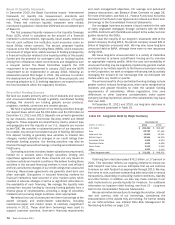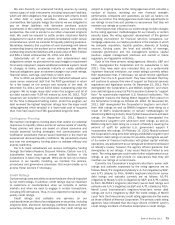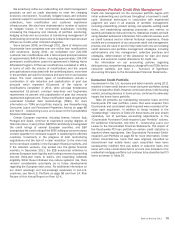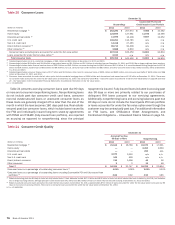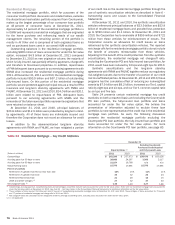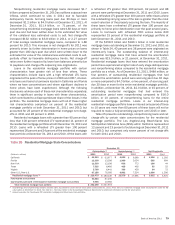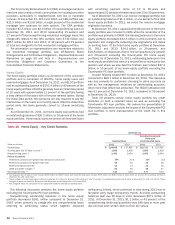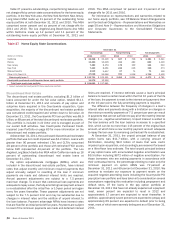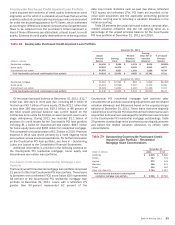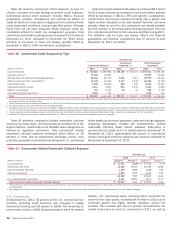Bank of America 2011 Annual Report Download - page 83
Download and view the complete annual report
Please find page 83 of the 2011 Bank of America annual report below. You can navigate through the pages in the report by either clicking on the pages listed below, or by using the keyword search tool below to find specific information within the annual report.Bank of America 2011 81
In some cases, the junior-lien home equity outstanding balance
that we hold is current, but the underlying first-lien is not. For
outstanding balances in the home equity portfolio in which we
service the first-lien loan, we are able to track whether the first-
lien loan is in default. For loans in which the first-lien is serviced
by a third party, we utilize credit bureau data to estimate the
delinquency status of the first-lien. Given that the credit bureau
database we use does not include a property address for the
mortgages, we are unable to identify with certainty whether a
reported delinquent first mortgage pertains to the same property
for which we hold a second- or more junior-lien loan. As of
December 31, 2011, we estimate that $4.7 billion of current
second- or more junior-lien loans were behind a delinquent first-
lien loan. We service the first-lien loans on $1.3 billion of that
amount, with the remaining $3.4 billion serviced by third parties.
Of the $4.7 billion current second-lien loans, we estimate based
on available credit bureau data as discussed above that
approximately $2.5 billion had first-lien loans that were 120 days
or more past due, of which approximately $2.1 billion had first-
lien loans serviced by third parties.
Net charge-offs decreased $2.3 billion to $4.5 billion, or 3.77
percent of the total average home equity portfolio, for 2011
compared to $6.8 billion, or 5.10 percent, for 2010 primarily driven
by favorable portfolio trends due in part to improvement in the
U.S. economy. In addition, the net charge-off amounts during 2010
were impacted by the implementation of regulatory guidance on
collateral-dependent modified loans which resulted in
$822 million in net charge-offs. Net charge-off ratios were further
impacted by lower outstanding balances primarily as a result of
paydowns and charge-offs outpacing new originations and draws
on existing lines.
There are certain characteristics of the outstanding loan
balances in the home equity portfolio that have contributed to
higher losses including those loans with a high refreshed combined
loan-to-value (CLTV), loans that were originated at the peak of home
prices in 2006 and 2007 and loans in geographic areas that have
experienced the most significant declines in home prices. Home
price declines coupled with the fact that most home equity
outstandings are secured by second-lien positions have
significantly reduced and, in some cases, eliminated all collateral
value after consideration of the first-lien position. Although the
disclosures below address each of these risk characteristics
separately, there is significant overlap in outstanding balances
with these characteristics, which has contributed to a
disproportionate share of losses in the portfolio. Outstanding
balances in the home equity portfolio with all of these higher risk
characteristics comprised 10 percent of the total home equity
portfolio at both December 31, 2011 and 2010, but have
accounted for 28 percent of the home equity net charge-offs in
2011 and 29 percent in 2010.
Outstanding balances in the home equity portfolio with greater
than 90 percent but less than 100 percent refreshed CLTVs
comprised 11 percent of the home equity portfolio at both
December 31, 2011 and 2010. Outstanding balances with
refreshed CLTVs greater than 100 percent comprised 32 percent
and 30 percent of the home equity portfolio at December 31, 2011
and 2010. Outstanding balances in the home equity portfolio with
a refreshed CLTV greater than 100 percent reflect loans where the
carrying value and available line of credit of the combined loans
are equal to or greater than the most recent valuation of the
property securing the loan. Depending on the value of the property,
there may be collateral in excess of the first-lien that is available
to reduce the severity of loss on the second-lien. Home price
deterioration over the past several years has contributed to an
increase in CLTV ratios. Of those outstanding balances with a
refreshed CLTV greater than 100 percent, 95 percent of the
customers were current at December 31, 2011. For second-lien
loans with a refreshed CLTV greater than 100 percent that are
current, 89 percent were also current on the underlying first-lien
loans at December 31, 2011. Outstanding balances in the home
equity portfolio to borrowers with a refreshed FICO score below
620 represented 12 percent of the home equity portfolio at both
December 31, 2011 and 2010.
Of the $112.7 billion in total home equity portfolio
outstandings, 78 percent and 75 percent at December 31, 2011
and 2010 were originated as interest-only loans, almost all of
which were HELOCs. The outstanding balance of HELOCs that have
entered the amortization period was $1.6 billion, or two percent
of total HELOCs, at December 31, 2011. The HELOCs that have
entered the amortization period have experienced a higher
percentage of early stage delinquencies and nonperforming status
when compared to the HELOC portfolio as a whole. As of
December 31, 2011, $49 million, or three percent, of outstanding
HELOCs that had entered the amortization period were accruing
past due 30 days or more compared to $1.4 billion, or one percent,
of outstanding accruing past due 30 days or more for the entire
HELOC portfolio. In addition, at December 31, 2011, $57 million,
or four percent, of outstanding HELOCs that had entered the
amortization period were nonperforming compared to $2.0 billion,
or two percent, of outstandings that were nonperforming for the
entire HELOC portfolio. Loans in our HELOC portfolio generally
have an initial draw period of 10 years and more than 85 percent
of these loans will not be required to make a fully-amortizing
payment until 2015 or later.
Although we do not actively track how many of our home equity
customers pay only the minimum amount due on their home equity
loans and lines, we can infer some of this information through a
review of our HELOC portfolio that we service and that is still in
its revolving period (i.e., customers may draw on and repay their
line of credit, but are generally only required to pay interest on a
monthly basis). During 2011, approximately 51 percent of these
customers did not pay down any principal on their HELOCs.



